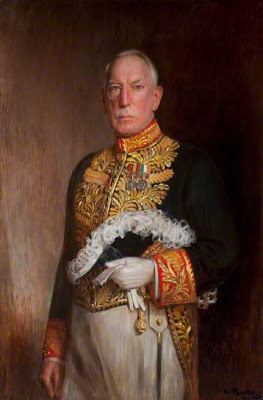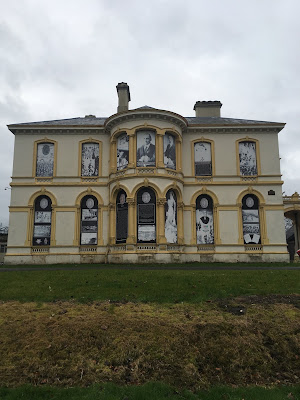THE EARLS FITZWILLIAM OWNED 115,743 ACRES OF LAND: 89,891 ACRES IN COUNTY WICKLOW, 22,192 ACRES IN YORKSHIRE, 1,532 ACRES IN COUNTY KILDARE, 881 ACRES IN NORTHAMPTONSHIRE, 522 ACRES IN CAMBRIDGESHIRE, 325 ACRES IN COUNTY WEXFORD, 308 ACRES IN DERBYSHIRE, 75 ACRES IN HUNTINGDONSHIRE, AND 17 ACRES IN LINCOLNSHIRE.
The family of FITZWILLIAM is of an antiquity equalled by few, and surpassed by none in England.
WILLIAM, son of Godric, married Aubreye, daughter of Robert de Lizour (she was born about 1130, and married firstly, Richard FitzEustace, Baron of Halton, County Palatine of Chester, and had issue, John, Constable of Chester).
In 1178, William rendered account of ten Marks for his marriage with the mother of John the Constable.
The lands of Aubreye de Lizour were divided between the issue of her two marriages, the Lacy lands to the heirs of John the Constable, and the lands of Lizour to William her son by her second marriage.
William, son of Godric, sometimes styled William de Clairfait, was a follower of KING STEPHEN, and founded the monastery of Hampole.
His son,
WILLIAM, was possessed of eight knights' fees in Yorkshire, as heir of his mother.
He used a seal on which he is shown on horseback with the Arms of Fitzwilliam on a shield on his arm.
He is said to have been in arms against KING JOHN and to have returned to his allegiance in the fifth year of HENRY III's reign.
His son and heir,
THOMAS FITZWILLIAM, styled grandson of Aubreye de Lizour, had free warren in 1253 in his lands in Yorkshire and Nottinghamshire.
At the battle of Chesterfield in 1266 he was made prisoner by HENRY III.
He wedded Agnes, daughter of Roger Bertram (and received a Manor and a rent with her), and had issue,
WILLIAM FITZ THOMAS, who pleaded before the commissioners of EDWARD I that he claimed in his lands of Sprotbrough, Yorkshire, the rights of assize which his ancestors had there since the Conquest.
His son,
SIR WILLIAM FITZWILLIAM, of Sprotbrough, who in the 29th year of the reign of EDWARD I was in the Scottish wars, but in the next reign joined in the great insurrection of Thomas, Earl of Lancaster and, being made prisoner with that nobleman at the battle of Boroughbridge in 1322, was hanged at York immediately afterwards.
He espoused Agnes, daughter of Richard, Lord Grey of Codnor, and dvp, leaving an only son,
SIR WILLIAM FITZWILLIAM who was summoned as a Baron in the first year of the reign of EDWARD III to the Muster of Arms, but never afterwards as Baron or to Parliament as such.
He wedded Maud, daughter of Edmund, Lord Deincourt, and had several children, of whom,
SIR JOHN FITZWILLIAM, who founded in 1372 St Edward's Chantry in the church of Sprotbrough; and having wedded Elizabeth, daughter of William, Lord Clinton, had three sons, one of whom - Edmond - was ancestor of William FitzWilliam, Earl of Southhampton.
The eldest son,
SIR WILLIAM FITZWILLIAM, married Maud, daughter of Ralph, Lord Cromwell, of Tattershall and co-heir of the Lord Treasurer Cromwell, by whom he had one son and two daughters, and was succeeded by the former,
SIR JOHN FITZWILLIAM, of Sprotbrough, who wedded Eleanor, daughter of Sir Henry Green, of Drayton, and died in 1418, having had six sons and a daughter.
The branch of the family at Sprotbrough became extinct in 1516 but there were several other branches in existence at that time.
In 1565 the family history was written by Hugh FitzWilliam who called himself "of Sprotbrough."
The youngest son of Sir John Fitzwilliam,
JOHN FITZWILLIAM, of Milton, and Greens Norton, Northamptonshire, married Eleanor, daughter of William Villiers, of Brooksby, Leicestershire, by whom he had three sons and two daughters, and was succeeded by his eldest son,
SIR WILLIAM FITZWILLIAM (
c1460-1534), of Milton and Gaynes Park, Essex, and also of the City of London, of which he was Sheriff in 1506, and subsequently Alderman of Bread Street Ward.
He wedded thrice: firstly, Anne, daughter of Sir John Hawes, Knight, of the City of London; secondly, Mildred, daughter of Richard Sackville; and thirdly, Jane, daughter and co-heiress of John Ormond.
The eldest son,
SIR WILLIAM FITZWILLIAM, Knight, who espoused Anne, daughter of Sir Richard Shapcote, of Elton, Huntingdonshire, and had three sons and one daughter.
Sir William died in 1576, and was succeeded by his eldest son,
This eminent person is thus noticed by Fuller, in his Worthies of England:
"Sir William Fitzwilliam was five times Lord Deputy of Ireland, a sufficient evidence of his honesty and ability, ELIZABETH I never trusting twice where she was once deceived in a Minister of State. And she so preserved him in the power of his office, that, when sending over Walter, Earl of Essex, to be Governor of Ulster, the Earl was ordered to take his commission from the Lord Deputy."
Sir William wedded Agnes, daughter of Sir William Sydney, and aunt of the 1st Earl of Leicester, and had issue.
He died in 1599, and was succeeded by his son,
SIR WILLIAM FITZWILLIAM, of Milton and Gaynes Park Hall, who married Winifred, daughter of the Rt Hon Sir Walter Mildmay, Knight, Chancellor of the Exchequer, and Under-Treasurer of England; and died in 1618, being succeeded by his elder son,
WILLIAM FITZWILLIAM (1577-1643), who was elevated to the Peerage of Ireland, by letters patent, dated at Westminster, 1620, in the dignity of Baron Fitzwilliam of Liffer, alias Lifford, County Donegal.
His lordship married Catherine, daughter of William Hyde, of South Denchworth, Berkshire; and died in 1643, being succeeded by his elder son,
WILLIAM, 2nd Baron (
c1609-58), who espoused, 1638, Jane, daughter and co-heir of Hugh Perry, otherwise Hunter, Alderman of London, and had, with another son (
dsp),
WILLIAM, his successor;
Jane, m Sir Christopher Wren, the celebrated architect.
His lordship was succeeded by his eldest surviving son,
WILLIAM, 3rd Baron (1643-1719); advanced to an Irish viscountcy and earldom, 1716, as Viscount Milton, County Westmeath, and EARL FITZWILLIAM, County Tyrone.
He married, in 1669, daughter and sole heir of Edmund Cremor, of West Winch, Norfolk, by whom he had four sons and six daughters, and was succeeded by his third, but eldest surviving son,
 |
| Coat-of-arms of John, 2nd Earl Fitzwilliam (Image: NLI) |
JOHN, 2nd Earl (c1685-1728), who wedded, in 1718, Anne, daughter and sole heir of John Stringer, of Sutton cum Lound, Nottinghamshire, by whom he had issue (with three daughters), a son and successor,
WILLIAM, 3rd Earl (1719-56); who was enrolled amongst the Peers of Great Britain by GEORGE II, 1742, in the dignity of Baron Fitzwilliam, of Northamptonshire; and advanced, 1746, to an English viscountcy and earldom, as Viscount Milton and EARL FITZWILLIAM.
He espoused, in 1744, the Lady Anne Watson-Wentworth, eldest daughter of
Thomas, 1st Marquess of Rockingham, KB, and sister and co-heir of the 2nd Marquess, by whom he had issue, two sons and six daughters, of whom the elder son,
WILLIAM, 4th Earl (1748-1833), Lord Lieutenant of Ireland for a very short period, in 1795, wedded firstly, 1770, the Lady Charlotte Ponsonby, second daughter of 2nd Earl of Bessborough, by the Lady Caroline Cavendish, his wife, daughter of 3rd Duke of Devonshire, and had an only child,
CHARLES WILLIAM WENTWORTH, his successor as 5th Earl.
He married secondly, in 1823, Louisa, fourth daughter of 3rd Viscount Molesworth, and widow of 1st Baron Ponsonby, by whom he had no further issue.
His lordship was succeeded by his only son,
CHARLES WILLIAM, 5th Earl (1786-1857), KG, who wedded, in 1806, Mary, fourth daughter of 1st Baron Dundas, by whom he had numerous issue, of whom the eldest surviving son,
WILLIAM THOMAS SPENCER, 6th Earl (1815-1902), KG, who espoused, in 1838, the Lady Frances Harriet Douglas, eldest daughter of George, 17th Earl of Morton, by whom he had numerous issue.
His lordship's eldest son and heir, William, styled Viscount Milton, dvp 1877, and the 6th Earl was consequently succeeded by his grandson,
WILLIAM (Billy) CHARLES DE MEURON, as 7th Earl (1872-1943), KCVO, CBE, DSO, who married, in 1896, the Lady Maud Frederica Elizabeth Dundas, daughter of Lawrence, 1st Marquess of Zetland, and had issue,
WILLIAM HENRY LAWRENCE PETER, his successor;
Maud Lillian Elfreda Mary; Marjorie Joan Mary; Donatia Faith Mary; Helena Albreda Marie Gabriella.
His lordship was succeeded by his son and heir,
WILLIAM HENRY LAWRENCE PETER, 8th Earl (1910-48), DSC, who wedded, in 1933, Olive Dorothea, daughter of the Most Rev and Hon Benjamin John Plunket, Lord Bishop of Meath.
His lordship dying without male issue, the family honours reverted to his second cousin once removed,
ERIC SPENCER, as 9th Earl (1883-1952), who married, in 1912, Jessica Gertrude, daughter of R F Rowlands; the 9th Earl, however, had no male issue, and the honours reverted to his cousin,
WILLIAM THOMAS GEORGE, as 10th Earl (1904-79), who wedded, in 1956, Joyce Elizabeth Mary, daughter of Colonel Joseph Philip Langdale, of Houghton Hall, Yorkshire.
The 10th Earl died without issue, in 1979, and the titles expired.
Former seat ~ Wentworth Woodhouse, near Rotherham, Yorkshire.
Former residences ~ Coollattin, Shillelagh, County Wicklow; 4, Grosvenor Square, London; 10, Grosvenor Street, London.


















.JPG)




















